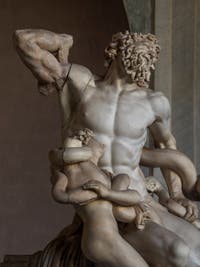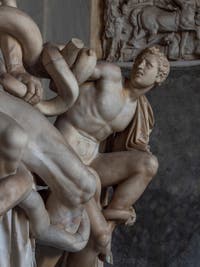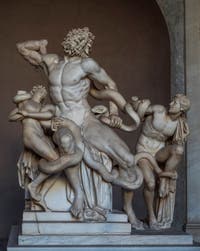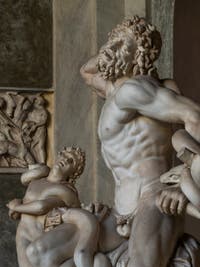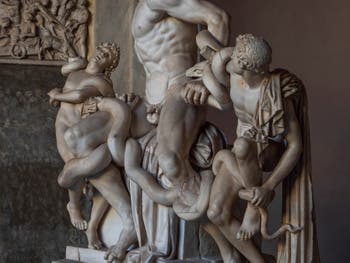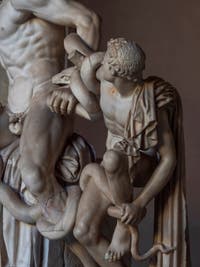Vatican Art Story | Location | Opening Hours Tickets | Authorisations
Art Story Sistine Chapel | Raphael | Caravaggio | da Vinci | Giotto | Titian | Veronese | Sculptures | Van Gogh |
Laocoön and his Sons in the Vatican Pio-Clementino Museum in Rome in Italy
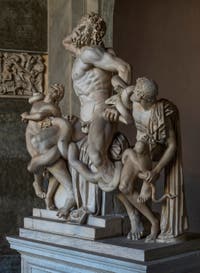
Laocoön and his Sons
Agesander, Polydore and Athenodore « Laocoön and his Sons »
Sculpture in Paros Marble (242×160cm) 40-30 BCThis marble sculpture of Paros represents the tragic death of Laocoön struggling with all his might to clear himself from the vice-like grip that encloses him with his sons, inexorably, stronger and stronger, before undergoing the deadly bite.
According to experts, this work is a copy of a Greek bronze original from the Hellenistic era is ascribed to the School of Pergamon (Asia Minor).
It was discovered on 14 January 1506 at the site rich in ancient Roman remains of the Esquiline Hill in Rome, witnessing two great Renaissance artists: Giuliano da Sangallo, and Michelangelo who had considered it exceptional.
In the first century AD, Pliny the Elder visited the palace of Emperor Titus in Rome, where he noticed a magnificent sculpture of Laocoön and quoted the names of the Greek artists who made it:
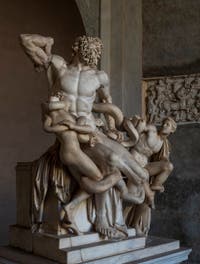
Laocoön and his Sons
« ... such is the Laocoön, in the palace of Titus, piece preferable to all productions either of painting or statuary; It is of a single block, as well as the admirable children and folds of snakes.
This group was done in concert by three excellent Rhodians artists, Agesander, Polydore and Athenodore. »
Pliny the Elder, Natural Stories, 2, 36.
Giuliano da Sangallo, who knew this extract from Pliny, immediately made the rapprochement and thought it was the same sculpture, without knowing whether it was an original or a copy of an older work.
And Michelangelo had noticed that she was not in one block as Pliny believed, but in four pieces so well assembled that only expert eyes could realize it.
Laocoön, figure of the tragic hero assaulted by a monstrous strength.

Laocoön and his Sons Laocoön's athletic body between his two sons is that of a man who desperately struggles against the fatality of an unjust and cruel death for him and his innocent children.
One of the two snakes literally raised from the ground and planted his fangs in the flank of the youngest already dying, his head thrown back, while his father struggled desperately not to suffer the same fate.
The inclination of Laocoön's head and body in the same direction as that of his youngest son shows that they are carried away in the same movement towards death.
Laocoön has legs practically tied to those of his sons, his muscles inflated and stretched to the extreme show that he is at the limit of his strength and that he will never be able to free himself from the infernal grip of the second snake ready to bite his flank.
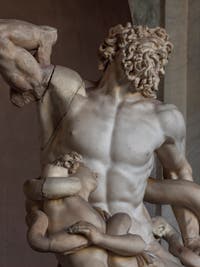
Laocoön and his Sons All this under the frightened gaze of the second son, helpless witness to the tragic death of his father, the snake already imprisoned him by his legs and hold his arm up to prevent him from fleeing.
Snakes wrap and tie around the limbs into a complex network that connects and imprisons the three bodies condemned to certain death.
By horizontally occupying the lower part of the entire statue, the powerful knots of reptiles emphasize the gestural beauty of the still standing human bodies.
At the top of the group, Laocoön's face expresses the suffering and pain of a man defeated by the evil that assaults him.
It was the face of the hero at the peak of his tragic death that foreshadowed the fall of Trojan.
Laocoön and the Trojan horse
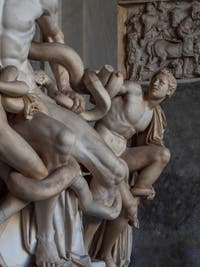
Laocoön and his Sons Laocoön's death is a crucial episode of Homer's famous Trojan War, in Iliad.
After many years of fighting in front of the ramparts of Troy without victors or defeats, the Greeks had ended up getting tired and wanted to return home.
On the advice of Ulysses, they feigned to leave the premises aboard their boats, leaving on site a magnificent gift apparently destined to Neptune, the god of the seas: a great wooden horse where warriors in arms were hiding.
The Trojans naively believed that the war was over and wanted to bring the horse into their city, but the priest Laocoön had opposed it by throwing his javelin into the sides of the horse, and crying out to warn them:
« I fear the Greeks, even when they make offerings! »
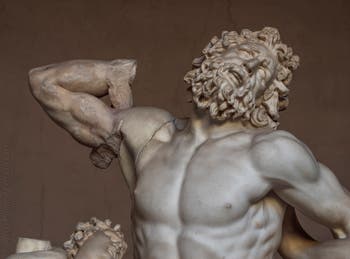
Laocoön and his Sons The cunning of the Greeks would not have worked without the intervention of a god favourable to their victory: from the bottom of the sea Neptune sent two monstrous serpents that hugged and killed Laocoön and his two sons.
A divine message, and therefore a positive sign for the Trojans who wanted to introduce the horse into their walls and celebrate the end of this long war, which they did immediately after, far from imagining that, at night, the warriors hidden inside would go out silently to open the doors to the Greek army returned to the place.
Surprised in their sleep, most of the Trojans were slaughtered and their city completely burned.
Only Prince Aeneas and his little troop (after trying to resist in vain) managed to flee Troy in flames with their families and embarked on a long journey to Italy.
Italy, where the descendants of Aeneas Remus and Romulus will be able to establish a new Troy called Rome.
Laocoön and the Romans
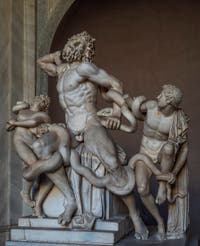
Laocoön and his Sons More than a thousand years after the fall of Troy, the Romans had become the masters of an empire, and their poets sang the history and victories of their glorious founding ancestors of their capital.
Virgil, born in — 70 near Mantua, began writing the Aeneid in -29 to tell the fall of Troy, the flight of Aeneas and his companions, followed by their odyssey until they settled in Lazio where their descendants founded Rome.
Thus, after having appeared in the Greek national epic (Homer's Iliad), the story of Laocoön will also be found in Virgil's Aeneid, which tells the Roman national epic from the fall of Troy (1200 BC) to the battle of Actium won in -31 by the future Emperor Augustus, who will reign from the year 27 before. J-C. Until the year AD 14.

Laocoön and his Sons Augustus's best friend was called Maecenas, the famous patron of the arts and letters whose palace had become one of the high places of Roman civilization, so that his name passed into posterity to designate generous art lovers. (mecenate in Italian)
Upon the death of Maecenas in 8 BC, the emperor inherited his library as well as his magnificent palace surrounded by Hellenistic style gardens with terraces offering various views of the city of Rome.
Tiberius, future successor of Augustus, had asked Greek sculptors, whose activity extends from 40 to 10 BC, to make a statue of Laocoön from an original Greek bronze ascribed to the Pergamon School.
Pliny the Elder, who lived from the years 23 to AD 79, could therefore quote their name and admire their statue in the old Patron's palace which had become an imperial property.
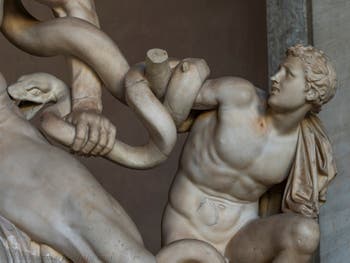
Laocoön and his Sons Original or copy, Sangallo and Michelangelo considered this sculpture by Laocoön and his children to be an exceptional model of the Hellenistic era.
They had been sent to the scene of his discovery by Pope Julius II who managed to acquire it in March 1506 by signing a contract with Felice de Freddi, the owner of the land.
The sculpture was immediately taken to the Vatican in a grand ceremony and to the sound of the bells, to be installed in the Court of Statues of the Belvedere Palace.
Laocoön, a revelation for Michelangelo
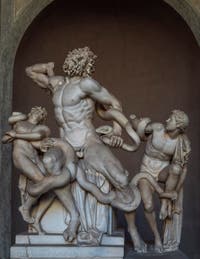
Laocoön and his Sons During the Renaissance, a period of return to the humanist values of ancients Greece and Roman, the discovery of this Laocoön was a sort of apparition that would revolutionize the artistic vision of the time.
It was a magnificent Hellenistic style sculpture that clearly distinguished itself from the serenity of the classical Greek statuary.
Michel Angel discovered a dramatic Greek work expressing suffering that brought her closer to Christian works, but it was above all a heroic suffering, even in agony.
« Hellenistic art offers Christian art its heroic form of pain.
Now can we understand then why this marble fascinated Rome, everyone applauded the exaltation of the nude relieved from the state of created being even into agony: a sovereign nude like that one of Aphrodite. »
André Malraux — The Unreal.
This sovereign nudity, sublimated by Michelangelo, adorned the ceiling of the Sistine Chapel in 1512.
Art Story Sistine Chapel | Raphael | Caravaggio | da Vinci | Giotto | Titian | Veronese | Sculptures | Van Gogh |
Vatican Art Story | Location | Opening Hours Tickets | Authorisations
Back to Top of Page


